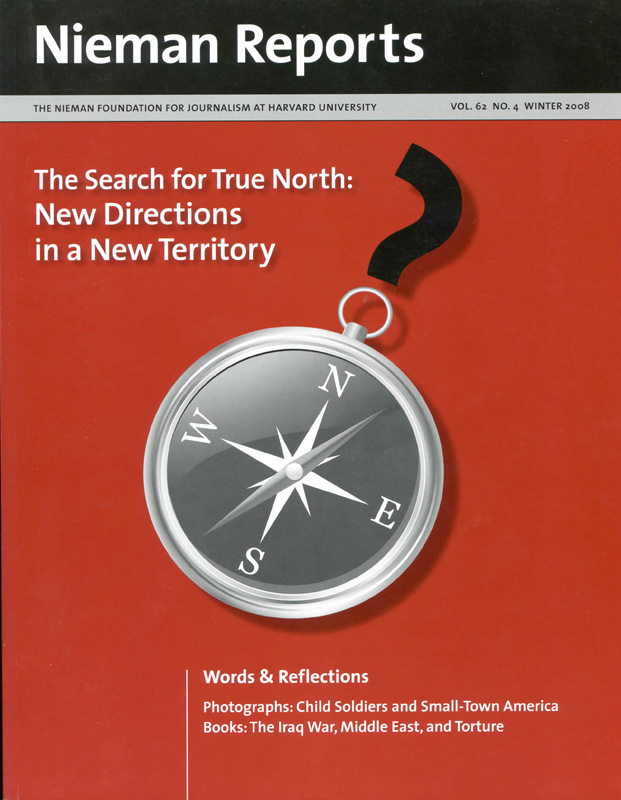RELATED ARTICLES
· “Engaging Young Staffers in Newsroom Activities and Change”
· “The Gang of Eight’s Recommendations: An Excerpt”
– Steven A. Smith“Here we go again.” That was the first thought that came to my mind when Managing Editor Gary Graham and I decided last summer that it was again time to reorganize The Spokesman-Review newsroom. In the six years plus that I had been Spokesman editor, I had already led three reorganizations, each following a forced staff reduction. This was to be the fourth.
As the staff had shrunk from about 140 full-time journalists when I arrived in mid-2002 to 104 by the end of 2007, so, too, had the nature of the newsroom’s work changed. During those five years, we’d moved from a print-centric culture to one supporting a strong multiplatform strategy. With fewer people to support more platforms—each with new challenges and opportunities in distributing our reporters’ work—it was clear to all of us that substantive reorganizations were necessary.
For two of our earlier efforts, we’d created newsroom task forces designed as working groups to make recommendations to the managing editor and me. Carla Savalli, first as city editor and later as senior editor for local news, led those two groups. “If I hear the term ‘zero basing’ one more time I’ll run screaming from the room,” she once told me.
The third reorganization, coming after the publisher ordered layoffs at the end of 2007, was top-down. Certainly, this wasn’t the best way to manage a depressed and angry newsroom, but it was deemed necessary given the time constraints Graham and I were facing. At the time, we decided we’d take another run at it—using a different approach—in mid-2008.
But no zero basing, this time around. Old-think was not helping us to staff our various platforms. Bold new ideas were required, and to get them we’d need to tap the energy and smarts of staffers traditionally left on the sidelines. What little hiring we’d been able to do in the past few years had brought into the newsroom some of the brightest young staff members with whom I’d ever worked. Although our open news meetings and open-door office policies had given these staff members some sense of having a voice within the newsroom, we wanted now to involve them even more.
They have a familiarity with new media that we, as older news people, don’t. They are more accustomed than most of us newsroom veterans to seeking out digital news, using mobile devices to read their news and search the Internet, participating in social networks, and producing and using multimedia. Print is just a piece of their media experience and, for many of them, it is a diminishing one. Certainly, our medium’s future will be left to them to shape as my generation of editors and reporters moves to the sidelines.
This awareness pointed us toward a recognition that this reorganization needed to be as much about their future as our present. With this in mind, in early July, I appointed a task force of eight young journalists—nearly all under the age of 30 who’d been hired within the past two years. They offered representation from nearly every newsroom department.
Start with a blank sheet of paper, I instructed them. On it, put down ways we can reinvent our newsroom. They had 10 days to produce a report for the managing editor and me, later to be shared with the staff and public. To do this, we took them off their regular assignments, provided them with a meeting room, and promised overtime (and food) if their work extended beyond business hours. They had “subpoena” power to call anyone in the newsroom to the table to answer questions about how things work or, more importantly, how they should work. Lack of imagination led me to call this group “the reorganization task force.” In the newsroom, they quickly became the “Gang of Eight.”
And all of them knew that the gang would not be making any final decisions. Those were to be left to the managing editor and me. Further, I let them know that I’d be asking other groups to participate before the process ended.
Ideas Emerge
After working around the clock for those 10 days, the Gang of Eight finished its report on July 10, 2008. They’d talked with dozens in the newsroom and others in the company. They’d studied newsroom structures other newspapers use, examined deadline schedules and production limitations. The report’s first sentence set the tone.
To efficiently run a newsroom that is dedicated to publishing content online, the deadline model for a traditional morning newspaper must be abandoned … the newsroom should operate as an afternoon paper would, though The Spokesman-Review will remain a morning newspaper.
We had talked about a new deadline structure before, of course. But veteran newsroom editors, many with experience at P.M. newspapers, hadn’t considered such a radical shift.
In their 12-page report, the Gang of Eight presented a new content strategy, deadline structure, organizational charts, shifts in editing and beat assignments, and new departments responsible for supervising not just what goes on our Web site but also on our new AM radio operation as well. Of course, some of their ideas were tried and true, if not in Spokane then elsewhere. Others were unsophisticated and unfinished.
They offered some surprises. In reorganizing local news reporting, our young staffers did not stray from the content that traditionalists typically value—watchdog and investigative reporting. And they recommended strengthening the copyediting system, particularly for online content. We’d been moving in the opposite direction.
At a general newsroom meeting, I presented the report to staffers. I also posted it on my blog. At the same time, I announced the formation of a second study group—consisting of a mix of staff, mostly veterans—to focus on content. By the end of July, this group issued its report. As might have been expected, they argued vigorously in favor of traditional news coverage, suggesting a reduction in the number of editors and an increase in the number of reporters on the ground. Most significant was a recommendation to cut the editorial page staff to two people, moving two into reporting slots and a third to the copy desk.
In August, we handed over both reports to five groups of six people. We gave each group a four-hour block of time to synthesize all of these ideas into a list of five or six basic recommendations. Meanwhile, I met one-on-one with as many newsroom staffers as I could, about 50 meetings of 30 to 60 minutes each.
With all of this information, Graham and I developed the reorganization plan, announced shortly after Labor Day and scheduled to go into effect at the end of September. By adjusting staff, downsizing the editorial page staff, and cutting a bit into features, we were able to add five reporters to the local news team, which was one of the leading goals of this effort. A breaking news desk was established to work early morning hours and produce content for online, mobile and radio. The editing structure was to be flattened and rearranged.
Ready for Change
This plan looked like it would work. For one reason, there appeared to be more buy-in from the staff. Reaction to it on my blog was mostly positive, and I was enthusiastic about giving it a try.
But we never had a chance to do so. In late September, the publisher mandated additional layoffs—as many as 25 to 30 positions. The reorganization plan blew up as if the newsroom had hit a land mine. I resigned on October 1st, protesting the scope of the layoffs. Among those let go, all on the basis of union-mandated seniority, were six members of the Gang of Eight and three of the nine members of the content study group. As many as three managers in addition to Savalli, who also resigned, and me, were set to leave. The online staff was eviscerated. The radio operation gutted.
It’s impossible to say if the youth-conceived reorganization would have worked. My view is that it would have held us in a good place until the time came when the newsroom could grow again. Instead, Graham, who is now editor, was faced with starting over. His will be the fifth reorganization effort in six years. He has a newsroom staff of about 80 serving four or more platforms.
Making this work—retaining quality and range of coverage that our readers expect from our news organization—will require not a task force, but a miracle.
Steven A. Smith was until October 1st editor of The Spokesman-Review in Spokane, Washington. His blog is www.stillanewspaperman.com.



